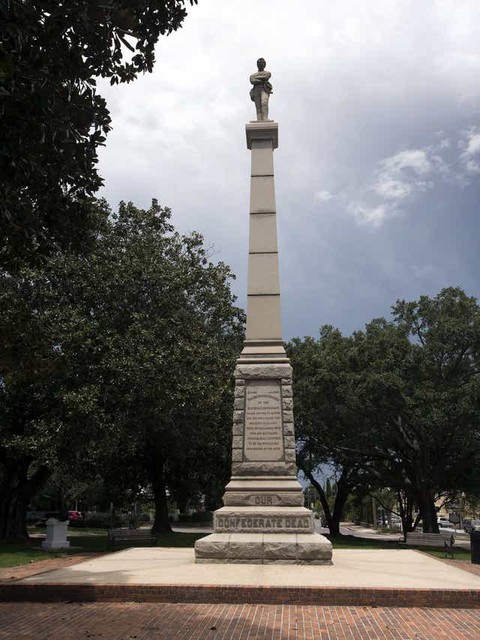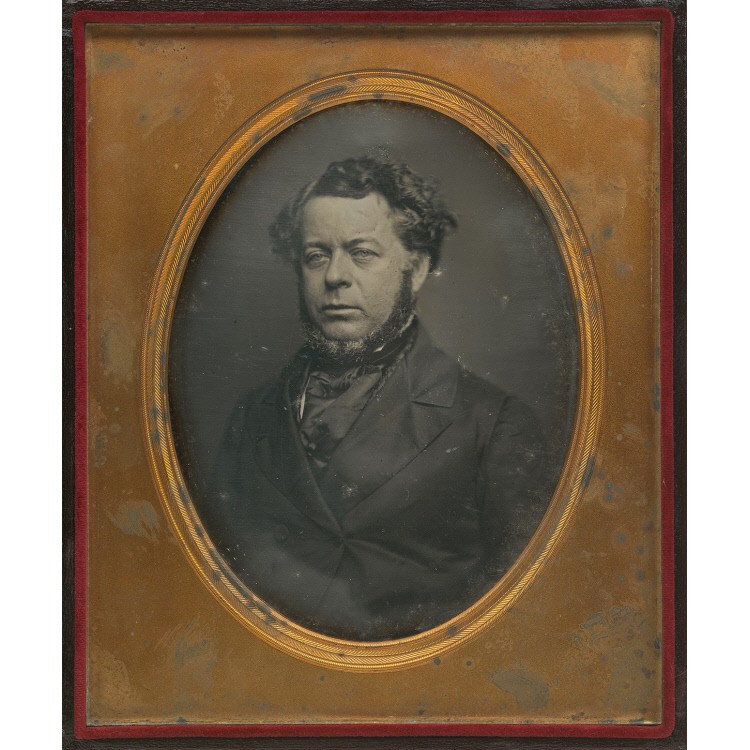Pensacola Confederate Monument
Introduction
Text-to-speech Audio
Images
KKK members march through Pensacola toward the Confederate monument on May 24, 1975

Pensacola Confederate Monument

Governor Edward A. Perry

Confederate Secretary of Navy Stephen R. Mallory

Confederate President Jefferson Davis

Removal of Pensacola Confederate monument

Backstory and Context
Text-to-speech Audio
The origins of Pensacola's Confederate monument begin with Edward Aynesworth Perry. Perry was a driving force in contemporary Florida politics and proved a fierce advocate for white supremacy. A former Confederate general, Perry was elected Florida's governor in 1885 and quickly moved to limit the political power of Florida's Black community. In Pensacola and several other Florida cities, the Knights of Labor movement had successfully created political coalitions of whites, Blacks, and Hispanics. Perry dissolved city charters and appointed all-white city governments in their stead. He and other Democrats likewise created a new state constitution which established polls taxes, effectively disenfranchising many African-American voters.
While Governor Edward Perry stripped Blacks of their voting rights and rejected democratically elected city governments, he also promoted the creation of a Confederate monument in the state capital Tallahassee. Yet following Perry's death in 1889, the project floundered. Most of the funds already raised originated from Escambia County, so the project was turned over to the locally established Ladies Confederate Monument Association in Pensacola, whose president Angela Mallory. The women raised $5,000 to build the monument, relying upon local donations and fundraisers. While the monument features a Confederate soldier standing vigil atop, the Ladies Association also determined to honor three Confederate leaders with inscriptions on the monument: President Jefferson Davis, Secretary of Navy Stephen Mallory (husband of Angela Mallory), and recently deceased Edward Perry. As. W. Stuart Town has pointed out, despite the gendered limitations of the 19th century, "Women were the prime movers of the Confederate monument building surge, and as a result, they left their mark on their communities."[6]
On June 17, 1891, thousands of people came out to witness the dedication of the 50-foot tall granite monument in the heart of Lee Square (renamed just a few years earlier in honor of Robert E. Lee). Ceremonies began with a parade through downtown Pensacola up Palafox Street towards Lee Square; local troops from around the region participated. A prayer was given, followed by speeches by Florida Governor Francis P. Fleming, Baptist Reverend J.H. Curry, and Colonel Robert W. Davis, where he spoke glowingly of the Confederate cause. Given the political atmosphere within Florida and the Lost Cause nature of the ceremony, the monument and its dedication were hardly apolitical. As scholar Andrew Barbero notes, "Those monuments were a message--they are a message to African Americans after Reconstruction letting them know that slavery doesn't exist anymore, but white supremacy is still the order of the day."[2]
Following its erection, Pensacola's Confederate monument continued to serve as a rallying ground for white supremacists throughout the late 19th and 20th centuries. In 1903, the statue was turned over to the local chapter of the United Daughters of the Confederacy, who routinely used the monument in Confederate Memorial Day ceremonies. In 1912, a large number of Confederate veterans gathered at the monument. During the keynote speech, Kirke Monroe declared that thought the Civil War was over, "the struggle for white supremacy" was underway. Monroe believed "that every man in this fair southland should devote his time and energy to promote the cause of white supremacy."[1] In 1975, the Ku Klux Klan marched through Pensacola before rallying in front of the Confederate monument in Lee Square. Although Lee Square itself shrunk throughout the 20th century, the Confederate statue remained.
In recent years, the monument and its racist legacy have come under greater scrutiny. In July 2020, in the midst of a nationwide reckoning over Confederate monuments, the Pensacola City Council determined to remove the Confederate monument and to likewise revert Lee Square back to its original name of Florida Square. As Pensacola's City Administrator Keith Wilkins stated, "Although the Confederate monument remembers those that led, fought and died for the Confederacy, it also promotes a post-Reconstruction 'Lost Cause' narrative that memorializes a divisive time in American history reflective of 'white supremacy' and the Jim Crow era."[3]
The monument's ultimate fate has yet to be determined. Several local groups, including the Sons of Confederate Veterans and Save Southern Heritage, are suing the city to prevent the monument's removal. Local St. John's Cemetery, where many of Florida's Confederate veterans rest, has offered to take the monument should it be removed.
As of October 26, 2020, the Pensacola Confederate monument has been removed by work crews. The statue will be transported to the Port of Pensacola as decisions will be made on where it will go next. The Pensacola City Council have voted 6-1 in July to change the name from Lee Square back to its original, Florida Square.[8]
Sources
1. Little, Jim. "A 'coup' led by white supremacists led to placement of Pensacola's Confederate monument." June 29, 2020. Pensacola News Journal. Web. Accessed July 13, 2020. https://www.pnj.com/story/news/2020/06/29/coup-white-supremacist-led-pensacolas-confederate-monument/3256660001/
2. Munoz, Jennifer. "The history behind Lee Square and Pensacola's Confederate monument." July 14, 2020. WEARTV ABC3. Web. Accessed July 15, 2020. https://weartv.com/news/local/pensacola-to-decide-the-fate-of-lee-square-in-special-meeting
3. Little, Jim. "Pensacola City Council votes to remove Confederate monument, change name of Lee Square." July 14, 2020. Pensacola News Journal. Web. Accessed July 15, 2020. https://www.pnj.com/story/news/2020/07/14/pensacola-city-council-votes-remove-confederate-monument-change-name-lee-square/5438879002/
4. Ortiz, Paul. Emancipation Betrayed: The Hidden History of Black Organizing and White Violence in Florida from Reconstruction to the Bloody Election of 1920. Berkeley: University of California Press, 2005.
5. Blanks, Annie. "St. John's Cemetery offers to take Confederate monument from downtown Pensacola." June 18, 2020. Pensacola News Journal. Web. Accessed July 15, 2020. https://www.pnj.com/story/news/2020/06/18/st-johns-cemetery-offers-house-pensacola-confederate-monument/3214600001/
6. Towns, W. Stuart. "Honoring the Confederacy in Northwest Florida: The Confederate Monument Ritual." Florida Historical Quarterly. Vol. 57, No. 2 (1978): 205-212.
7. Castor, Rebekah. "Multiple groups suing City of Pensacola to stop removal of Confederate monument." July 16, 2020. NBC 15. Web. Accessed July 16, 2020. https://mynbc15.com/news/local/multiple-groups-suing-the-city-of-pensacola-to-stop-removal-of-confederate-monument
8.Cerda, Carolyn. "Crews remove Pensacola Confederate monument.: October 26, 2020. WEAR3TV. Web.
Accessed October 28, 2020. https://weartv.com/news/local/crews-begin-removing-pensacolas-confederate-monument
University of West Florida Historic Trust, https://www.pnj.com/picture-gallery/news/2017/08/17/photos-kkk-marches-in-pensacola-in-1975/104700026/
Tony Giberson, Pensacola News Journal
Florida Memory, State Library & Archives of Florida, https://www.floridamemory.com/items/show/136925
National Portrait Gallery, Smithsonian, https://npg.si.edu/object/npg_NPG.79.115
National Archives, https://www.archives.gov/nhprc/projects/catalog/jefferson-davis
WEAR3TV, https://weartv.com/news/local/gallery/crews-begin-removing-pensacolas-confederate-monument#photo-5
